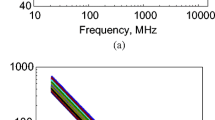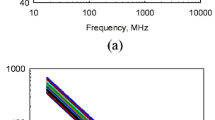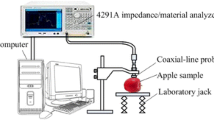Abstract
Water is the major component of milk. More water means less total solids concentration. Therefore, routine analysis on water content is very important in milk factory. To offer a new method for determining water content of milk in situ and in-line quality monitoring, dielectric spectroscopy, an instrumental method used to obtain spectra describing dielectric properties of materials, was used to determine the water content of milk in this study. The dielectric spectra of 161 milk samples were obtained at 201 discrete frequencies on a logarithmic scale from 20 to 4500 MHz at 25 °C. Ten, 34, and 14 optimal dielectric variables (ODVs) were extracted from the full dielectric spectra (FDS) with 402 dielectric variables by using successive projections algorithm (SPA), competitive adaptive reweighted sampling (CARS), and combination of CARS and SPA (CARS + SPA), respectively. Four models, including two linear models, i.e., multiple linear regression (MLR) and partial least squares regression (PLSR), and another two artificial neural network models, i.e., extreme learning machine (ELM) and least squares-support vector machine (LSSVM), were established. The artificial neural network models had better prediction performance than the linear models at the same ODV selection methods. Moreover, the ODVs extracted by CARS could give better prediction performance than SPA and CARS + SPA. Among all developed models, the FDS-LSSVM model had the lowest root mean squares error of prediction set (0.054%), followed by CARS-LSSVM with 0.094%. Few variables and high prediction precision of CARS-LSSVM have great potential in developing portable milk water detector used in situ and in-line inspection. This study indicated that dielectric spectroscopy is a promising approach for accurately determining the water content of milk.




Similar content being viewed by others
References
Araújo MCU, Saldanha TCB, Galvão RKH, Yoneyama T, Chame HC, Visani V (2001) The successive projections algorithm for variable selection in spectroscopic multicomponent analysis. Chemom Intell Lab Syst 57(2):65–73
Bhandari V, Singh H (2011) Physical methods. In: Fuquay JW, Fox PF, McSweeney PLH (Eds.), Encyclopedia of Dairy Science (second edition) (Vol. 1). London: Elsevier.
Chandan RC (2011) Dairy ingredients for food processing: an overview. In: Chandan RC, Kilara A (eds) Dairy ingredients for Food processing. Blackwell Publishing Ltd., Iowa, pp 5–6
da Costa GB, Fernandes DDS, Gomes AA, de Almeida VE, Veras G (2016) Using near infrared spectroscopy to classify soybean oil according to expiration date. Food Chem 196:539–543
Dong J, Guo W, Zhao F, Liu D (2017) Discrimination of "Hayward" kiwifruits treated with forchlorfenuron at different concentrations using hyperspectral imaging technology. Food Anal Methods 10(1):477–486
Guo W, Zhu X, Liu Y, Zhuang H (2010a) Sugar and water contents of honey with dielectric property sensing. J Food Eng 97(2):275–281
Guo W, Zhu X, Liu H, Yue R, Wang S (2010b) Effects of milk concentration and freshness on microwave dielectric properties. J Food Eng 99(3):344–350
Guo W, Liu Y, Zhu X, Wang S (2011a) Temperature-dependent dielectric properties of honey associated with dielectric heating. J Food Eng 102(3):209–216
Guo W, Zhu X, Nelson SO, Yue R, Liu H, Liu Y (2011b) Maturity effects on dielectric properties of apples from 10 to 4500MHz. LWT-Food Sci Technol 44(1):224–230
Guo W, Fang L, Liu D, Wang Z (2015a) Determination of soluble solids content and firmness of pears during ripening by using dielectric spectroscopy. Comput Electron Agric 117:226–233
Guo W, Shang L, Zhu X, Nelson S (2015b) Nondestructive detection of soluble solids content of apples from dielectric spectra with ANN and chemometric methods. Food Bioprocess Technol 8(5):1126–1138
Guo W, Gu J, Liu D, Shang L (2016a) Peach variety identification using near-infrared diffuse reflectance spectroscopy. Comput Electron Agric 123:297–303
Guo W, Zhao F, Dong J (2016b) Nondestructive measurement of soluble solids content of kiwifruits using near-infrared hyperspectral imaging. Food Anal Methods 9(1):38–47
He HJ, Sun DW (2015) Toward enhancement in prediction of Pseudomonas counts distribution in salmon fillets using NIR hyperspectral imaging. LWT-Food Sci Technol 62(1, Part 1):11–18
Kasemsumran S, Thanapase W, Kiatsoonthon A (2007) Feasibility of near-infrared spectroscopy to detect and to quantify adulterants in cow milk. Anal Sci 23(7):907–910
Li H, Liang Y, Xu Q, Cao D (2009) Key wavelengths screening using competitive adaptive reweighted sampling method for multivariate calibration. Anal Chim Acta 648(1):77–84
Li X, Zhang Y, He Y (2016) Rapid detection of talcum powder in tea using FT-IR spectroscopy coupled with chemometrics. Sci Rep 6:30313
Mabrook MF, Petty MC (2003) A novel technique for the detection of added water to full fat milk using single frequency admittance measurements. Sens Actuators B-Chemical 96(1–2):215–218
Martin JFG (2015) Optical path length and wavelength selection using Vis/NIR spectroscopy for olive oil’s free acidity determination. Int J Food Sci Technol 50(6):1461–1467
Melfsen A, Hartung E, Haeussermann A (2012) Accuracy of milk composition analysis with near infrared spectroscopy in diffuse reflection mode. Biosyst Eng 112(3):210–217
Moreira M, Franca JD, Filho DT, Beloti V (2016) A low cost NIR digital photometer based on InGaAs sensors for the detection of milk adulterations with water. IEEE Sensors J 16(10):3653–3663
Nicolaї BM, Beullens K, Bobelyn E, Peirs A, Saeys W, Theron KI, Lammertyn J (2007) Nondestructive measurement of fruit and vegetable quality by means of NIR spectroscopy: a review. Postharvest Biol Technol 46(2):99–118
Nunes AC, Bohigas X, Tejada J (2006) Dielectric study of milk for frequencies between 1 and 20 GHz. J Food Eng 76(2):250–255
Xie C, Xu N, Shao Y, He Y (2015) Using FT-NIR spectroscopy technique to determine arginine content in fermented Cordyceps sinensis mycelium. Spectrochim Acta A Mol Biomol Spectrosc 149:971–977
Zhan XR, Zhu XR, Shi XY, Zhang ZY, Qiao YJ (2009) Determination of hesperidin in tangerine leaf by near-infrared spectroscopy with SPXY algorithm for sample subset partitioning and Monte Carlo cross validation. Spectrosc Spectr Anal 29(4):964–968 (in Chinese)
Zhu X, Guo W, Wu X (2012) Frequency- and temperature-dependent dielectric properties of fruit juices associated with pasteurization by dielectric heating. J Food Eng 109(2):258–266
Zhu X, Fang L, Gu J, Guo W (2015) Feasibility investigation on determining soluble solids content of peaches using dielectric spectra. Food Anal Methods 9(6):1789–1798
Zhu X, Guo W, Kang F, Kong F, Zhu Q (2016) Determination of protein content of raw fresh cow’s milk using dielectric spectroscopy combined with chemometric methods. Food Bioprocess Technol 9(12):2092–2102
Acknowledgements
This work was financially supported by National Natural Science Foundation of China (No. 31671935).
Author information
Authors and Affiliations
Corresponding author
Ethics declarations
Conflict of Interest
Wenchuan Guo declares that she has no conflict of interest. Biying Lin and Dayang Liu declare that they have no conflict of interest. Xinhua Zhu declares that he has no conflict of interest.
Human and Animal Rights
All experiments involving animals were conducted according to the principles of the Chinese Academy of Agricultural Sciences Animal Care and Use Committee (Beijing, China), which approved the study protocols.
Informed Consent
Not applicable.
Funding
The study was financially supported by the project of National Natural Science Foundation of China (No. 31671935).
Rights and permissions
About this article
Cite this article
Guo, W., Lin, B., Liu, D. et al. A Novel Technique on Determining Water Content in Milk Using Radio-Frequency/Microwave Dielectric Spectroscopy and Chemometrics. Food Anal. Methods 10, 3781–3789 (2017). https://doi.org/10.1007/s12161-017-0946-7
Received:
Accepted:
Published:
Issue Date:
DOI: https://doi.org/10.1007/s12161-017-0946-7




